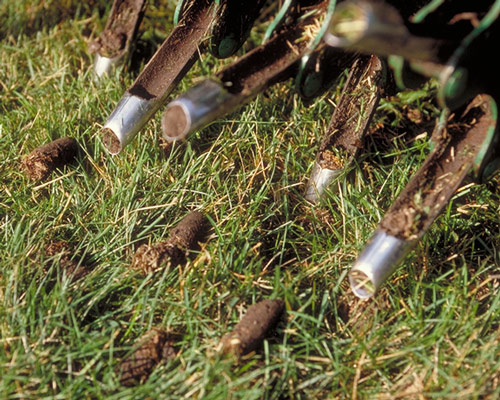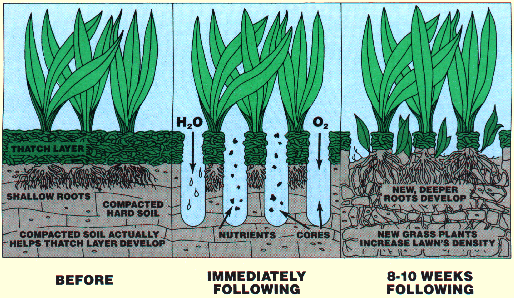Core Aeration
What is Core Aeration?
Core aeration involves
the removal of small soil plugs or cores out of the lawn. Aeration holes
are typically 1-4 inches deep and 2-6 inches apart. Other
types of aerators push solid spikes or tines into the soil without
removing a plug (spiking). These are not as effective because they can
contribute to compaction. Core aeration is a recommended lawn care
practice on compacted, heavily used turf and to control thatch buildup.

What will aeration do for my lawn?
As lawns age or sustain heavy
use from play, sports activities, pets, vehicle traffic and parking,
soil compaction can result. Soil compacting forces are most severe in
poorly drained or wet sites. Compaction greatly reduces the pore space
within the soil that would normally hold air. Roots require oxygen to
grow and absorb nutrients and water. Compaction reduces total pore space
and the amount of air within the soil. It has a negative impact on
nutrient uptake and water infiltration, in addition to being a physical
barrier to root growth. This results in poor top growth and lawn
deterioration. Core aeration can benefit your lawn by: - Increasing the activity of soil microorganisms that decompose thatch.
- Increasing water, nutrient and oxygen movement into the soil.
- Improving rooting.
- Enhancing infiltration of rainfall or irrigation.
- Helping prevent fertilizer and pesticide run-off from overly compacted areas.

How do I know if I need to aerate?
If in doubt about aeration, remove a square foot section of lawn at
least 6 inches deep. If grass roots extend only into the first 1-2
inches, your soil may be compacted and could benefit from core aeration.
Expect a seasonal effect with cool-season grass roots being shortest in
late summer and at their greatest depth in late spring.
Other reasons to aerate include:
- Your lawn is heavily used or driven upon on a regular basis, causing the turf to thin or look unthrifty.
- The thatch layer is in excess of 1/2 inch.
- You have a heavy clay soil.